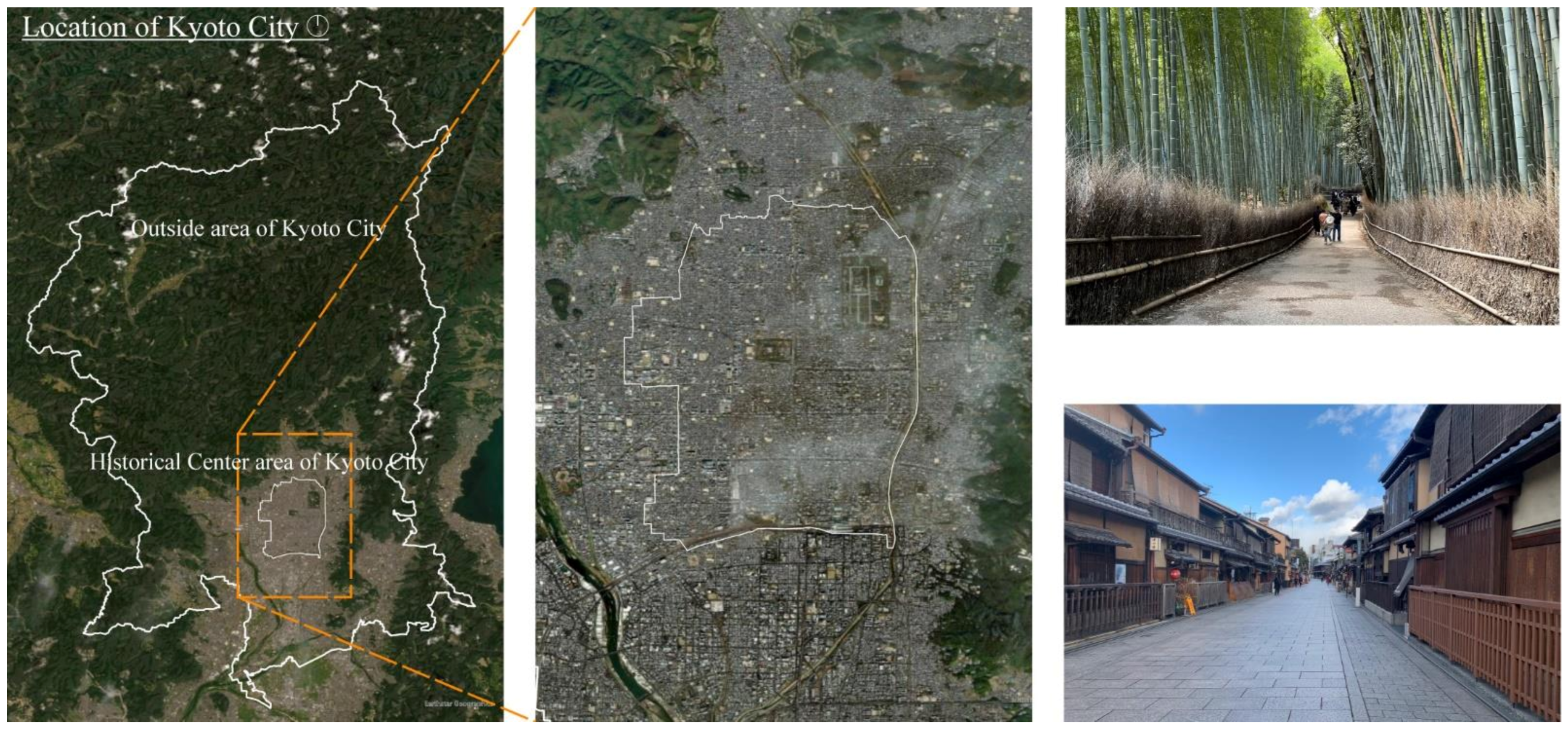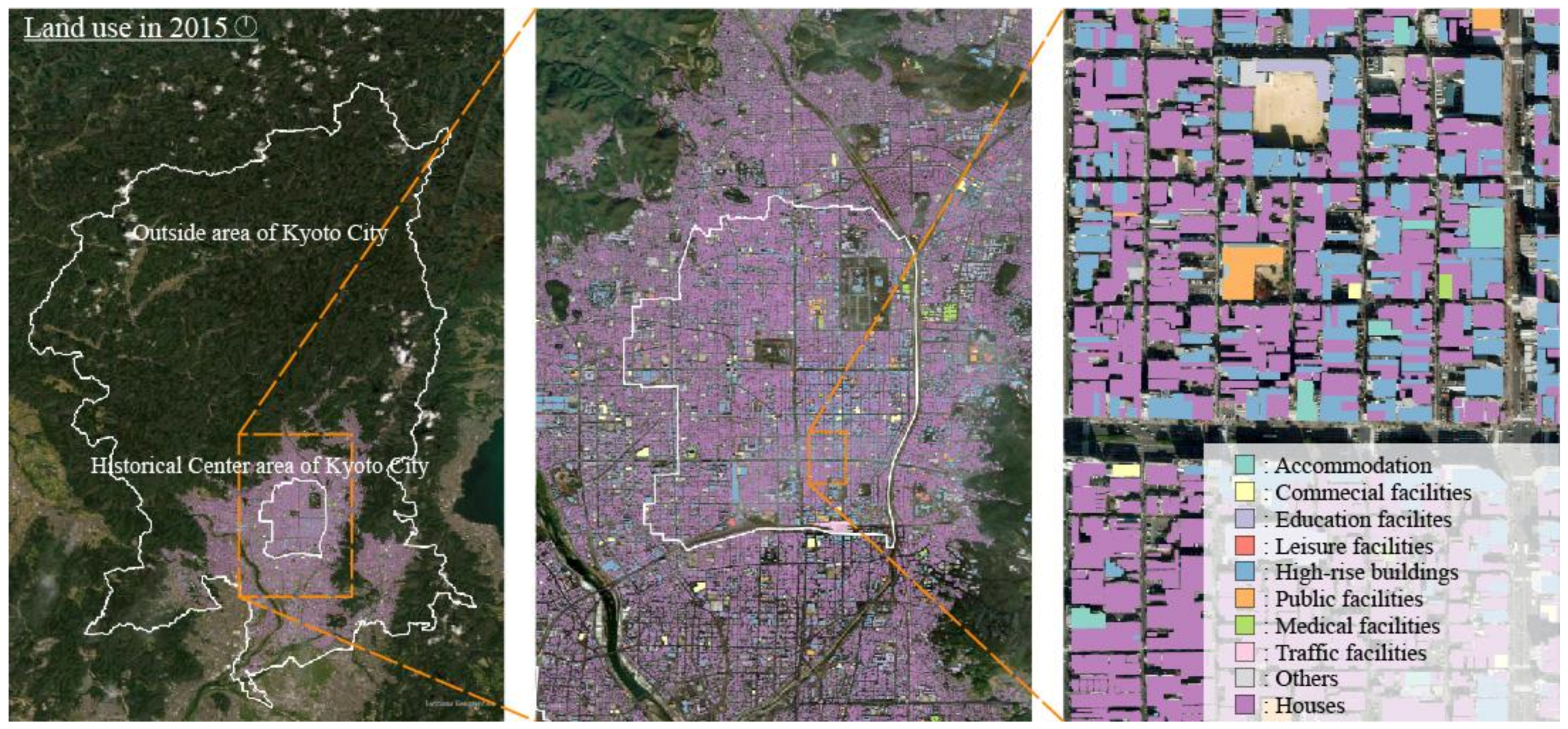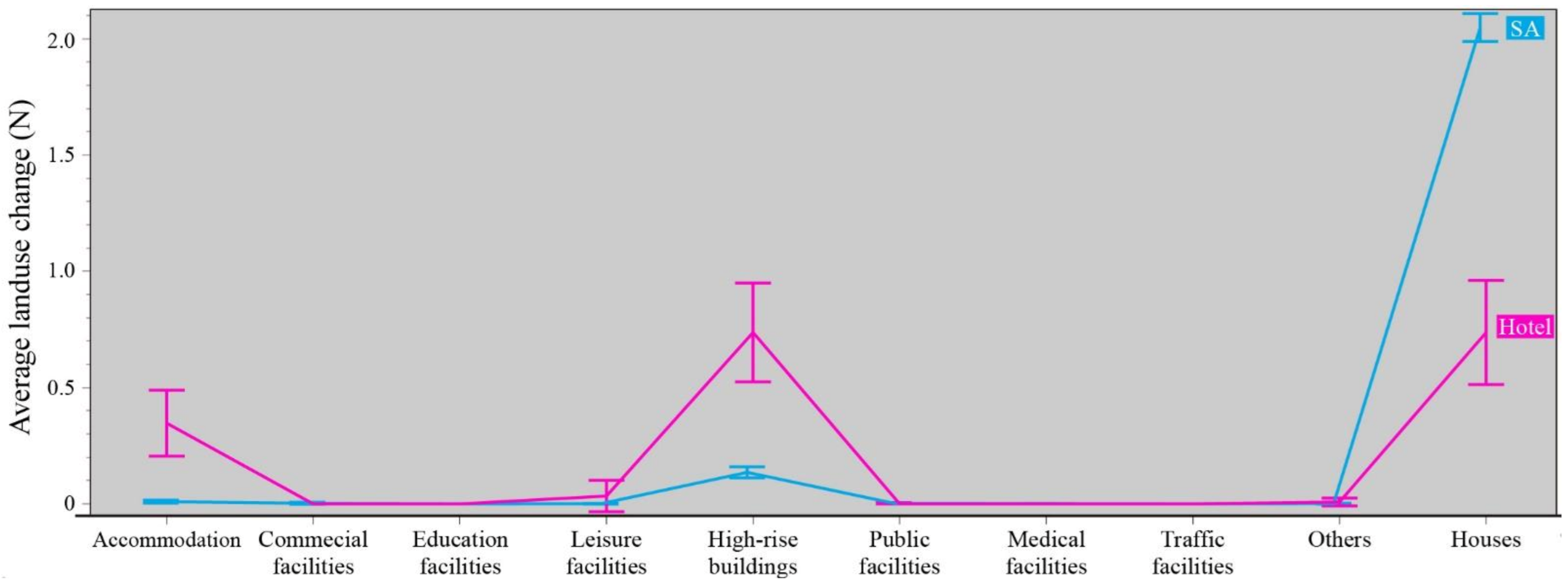Population Decline and Urban Transformation by Tourism Gentrification in Kyoto City
Abstract
:1. Introduction
2. Materials and Methods
2.1. Case Study: Kyoto City
2.2. Analysis Flow
2.3. Accommodation List
2.4. Census Data
2.5. Land Use Data
3. Results
3.1. Urban Transformation by Accommodation
3.2. Population Change
3.3. Accommodation and Urban Transformation
3.4. Urban Transformation and Population Change
4. Discussion
5. Conclusions
Author Contributions
Funding
Institutional Review Board Statement
Informed Consent Statement
Data Availability Statement
Conflicts of Interest
References
- Gotham, K.F. Tourism gentrification: The case of New Orleans’ Vieux Carre (French Quarter). Urban Stud. 2005, 42, 1099–1121. [Google Scholar] [CrossRef]
- Sigler, T.; Wachsmuth, D. New Directions in Transnational Gentrification: Tourism-Led, State-Led and Lifestyle-Led Urban Transformations. Urban Stud. 2020, 57, 3190–3201. [Google Scholar] [CrossRef]
- González-Pérez, J.M. The Dispute over Tourist Cities. Tourism Gentrification in the Historic Centre of Palma (Majorca, Spain). Tour. Geogr. 2020, 22, 171–191. [Google Scholar] [CrossRef]
- Barata-Salgueiro, T.; Guimarães, P. Public Policy for Sustainability and Retail Resilience in Lisbon City Center. Sustainability 2020, 12, 9433. [Google Scholar] [CrossRef]
- Oremusová, D.; Nemčíková, M.; Krogmann, A. Transformation of the Landscape in the Conditions of the Slovak Republic for Tourism. Land 2021, 10, 464. [Google Scholar] [CrossRef]
- Ashworth, G.; Page, S.J. Urban Tourism Research: Recent Progress and Current Paradoxes. Tour. Manag. 2011, 32, 1–15. [Google Scholar] [CrossRef]
- Hübscher, M. Megaprojects, Gentrification, and Tourism. A Systematic Review on Intertwined Phenomena. Sustainability 2021, 13, 12827. [Google Scholar] [CrossRef]
- Larsen, H.G.; Hansen, A.L. Gentrification—Gentle or Traumatic? Urban Renewal Policies and Socioeconomic Transformations in Copenhagen. Urban Stud. 2008, 45, 2429–2448. [Google Scholar] [CrossRef] [Green Version]
- Cocola-Gant, A. Place-Based Displacement: Touristification and Neighborhood Change. Geoforum 2023, 138, 103665. [Google Scholar] [CrossRef]
- Cocola-Gant, A.; Gago, A. Airbnb, Buy-to-Let Investment and Tourism-Driven Displacement: A Case Study in Lisbon. Environ. Plan. A Econ. Sp. 2021, 53, 1671–1688. [Google Scholar] [CrossRef]
- Ley, D. Gentrification, in the Dictionary of Human Geography, 5th ed.; Gregory, J., Johnson, R., Prett, G., Watts, M., Eds.; Wiley-Blackwell: Oxford, UK, 2009; pp. 273–374. [Google Scholar]
- LeGates, R.T.; Hartman, C. Gentrification-Caused Displacement. Urban Lawyer 1982, 14, 31–55. [Google Scholar]
- Liu, Y.; Lin, Y.; Fu, N.; Geertman, S.; van Oort, F. Towards Inclusive and Sustainable Transformation in Shenzhen: Urban Redevelopment, Displacement Patterns of Migrants and Policy Implications. J. Clean. Prod. 2018, 173, 24–38. [Google Scholar] [CrossRef]
- Sumka, H.J. Neighborhood Revitalization and Displacement A Review of the Evidence. J. Am. Plan. Assoc. 1979, 45, 480–487. [Google Scholar] [CrossRef]
- Betancur, J.J. The Politics of Gentrification. Urban Aff. Rev. 2002, 37, 780–814. [Google Scholar] [CrossRef]
- López-Gay, A.; Cocola-Gant, A.; Russo, A.P. Urban Tourism and Population Change: Gentrification in the Age of Mobilities. Popul. Space Place 2021, 27, e2380. [Google Scholar] [CrossRef]
- Parralejo, J.-J.; Díaz-Parra, I. Gentrification and Touristification in the Central Urban Areas of Seville and Cádiz. Urban Sci. 2021, 5, 40. [Google Scholar] [CrossRef]
- Ardura Urquiaga, A.; Lorente-Riverola, I.; Ruiz Sanchez, J. Platform-Mediated Short-Term Rentals and Gentrification in Madrid. Urban Stud. 2020, 57, 3095–3115. [Google Scholar] [CrossRef]
- Shadish, W.R.; Cook, T.D.; Campbell, D.T. Experimental and Quasi-Experimental Designs for Generalized Causal Inference; Houghton, Mifflin and Company: Boston, MA, USA, 2002; ISBN 0-395-61556-9. [Google Scholar]
- Kato, H.; Takizawa, A. Population Decline as Tourism Gentrification Caused by Accommodation in Kyoto City. Sustainability 2022, 14, 11736. [Google Scholar] [CrossRef]
- Wolfram, M.; Frantzeskaki, N.; Maschmeyer, S. Cities, Systems and Sustainability: Status and Perspectives of Research on Urban Transformations. Curr. Opin. Environ. Sustain. 2016, 22, 18–25. [Google Scholar] [CrossRef]
- Hölscher, K.; Frantzeskaki, N.; McPhearson, T.; Loorbach, D. Capacities for Urban Transformations Governance and the Case of New York City. Cities 2019, 94, 186–199. [Google Scholar] [CrossRef]
- OECD Local Economic and Employment Development. Socio-Economic Alliances in Response to North Kyoto Demographic Transition. Available online: https://www.oecd.org/employment/leed/OECD-Kyoto-report-Final.pdf (accessed on 10 November 2022).
- Hölscher, K.; Frantzeskaki, N. Perspectives on Urban Transformation Research: Transformations in, of, and by Cities. Urban Transform. 2021, 3, 2. [Google Scholar] [CrossRef]
- Sequera, J.; Nofre, J. Touristification, transnational gentrification and urban change in Lisbon: The neighbourhood of Alfama. Urban Stud. 2020, 57, 3169–3189. [Google Scholar] [CrossRef]
- Zhang, Y.; Chapple, K.; Cao, M.; Dennett, A.; Smith, D. Visualising Urban Gentrification and Displacement in Greater London. Environ. Plan. A Econ. Sp. 2020, 52, 819–824. [Google Scholar] [CrossRef]
- Almeida-García, F.; Cortés-Macías, R.; Parzych, K. Tourism Impacts, Tourism-Phobia and Gentrification in Historic Centers: The Cases of Málaga (Spain) and Gdansk (Poland). Sustainability 2021, 13, 408. [Google Scholar] [CrossRef]
- Garcia-Ayllon, S. Urban Transformations as an Indicator of Unsustainability in the P2P Mass Tourism Phenomenon: The Airbnb Case in Spain through Three Case Studies. Sustainability 2018, 10, 2933. [Google Scholar] [CrossRef] [Green Version]
- Domínguez-Mujica, J.; González-Pérez, J.M.; Parreño-Castellano, J.M.; Sánchez-Aguilera, D. Gentrification on the Move. New Dynamics in Spanish Mature Urban-Tourist Neighborhoods. Urban Sci. 2021, 5, 33. [Google Scholar] [CrossRef]
- Álvarez-Herranz, A.; Macedo-Ruíz, E. An Evaluation of the Three Pillars of Sustainability in Cities with High Airbnb Presence: A Case Study of the City of Madrid. Sustainability 2021, 13, 3220. [Google Scholar] [CrossRef]
- ArcGIS REST Services Directory. Available online: https://services.arcgisonline.com/ArcGIS/rest/services/World_Imagery/MapServer (accessed on 29 June 2022).
- Funo, S. Ancient Chinese Capital Models—Measurement System in Urban Planning—. Proc. Japan Acad. Ser. B Phys. Biol. Sci. 2017, 93, 724–745. [Google Scholar] [CrossRef]
- UNESCO (United Nations Educational, Scientific, and Cultural Organization). Historic Monuments of Ancient Kyoto (Kyoto, Uji and Otsu Cities). Available online: https://whc.unesco.org/en/list/688/ (accessed on 11 November 2022).
- Japan Tourism Agency. The Tourism Nation Promotion Basic Plan (30 March 2012). Available online: https://www.mlit.go.jp/common/000234920.pdf (accessed on 11 November 2022).
- Ministry of Foreign Affairs of Japan. Border Measures to Prevent the Spread of Novel Coronavirus (6 September 2022). Available online: https://www.mofa.go.jp/ca/fna/page4e_001053.html (accessed on 11 November 2022).
- Kato, H. Residents’ Evaluations of the Tourism Gentrification Caused by Guesthouses in the Central Area of Kyoto City: A Case Study of Shutoku District in Kyoto City. IOP Conf. Ser. Mater. Sci. Eng. 2020, 960, 032063. [Google Scholar] [CrossRef]
- Brumann, C. Outside the glass case: The social life of urban heritage in kyoto. Am. Ethnol. 2009, 36, 276–299. [Google Scholar] [CrossRef]
- Kato, H. Effect of Walkability on Urban Sustainability in the Osaka Metropolitan Fringe Area. Sustainability 2020, 12, 9248. [Google Scholar] [CrossRef]
- Kato, H. How Does the Location of Urban Facilities Affect the Forecasted Population Change in the Osaka Metropolitan Fringe Area? Sustainability 2021, 13, 110. [Google Scholar] [CrossRef]
- Kato, H.; Takizawa, A. Which Residential Clusters of Walkability Affect Future Population from the Perspective of Real Estate Prices in the Osaka Metropolitan Area? Sustainability 2021, 13, 13413. [Google Scholar] [CrossRef]
- Kyoto City Government. Building Agreement for Accommodation Facilities in Ichimatsu-Cho Neighborhood Association, Kamigyo Ward, Kyoto City. Available online: https://www.city.kyoto.lg.jp/tokei/cmsfiles/contents/0000021/21238/itimatu_syukuhaku.pdf (accessed on 10 November 2022).
- Kyoto City Information Centre. List of Accommodations in Kyoto City. Available online: https://minpakuportal.city.kyoto.lg.jp/wp-content/uploads/2022/10/202209itiraneng.pdf (accessed on 11 November 2022).
- Japanese Law Translation. Hotel Business Act. Available online: https://www.japaneselawtranslation.go.jp/ja/laws/view/3272/je (accessed on 11 November 2022).
- Kyoto City Official Website. Concerning the Use of Minpaku Accommodations as Well as the Offering of Minpaku Services. Available online: https://www.city.kyoto.lg.jp/hokenfukushi/page/0000194935.html (accessed on 11 November 2022).
- E-Stat. Japanese Census Data in 2015 (Subregional Boundary Data, Kyoto Prefecture). Available online: https://www.e-stat.go.jp/stat-search/files?page=1&layout=datalist&toukei=00200521&tstat=000001080615&cycle=0&tclass1=000001094495&tclass2=000001094525&stat_infid=000031522145&cycle_facet=cycle&tclass3val=0 (accessed on 11 November 2022). (In Japanese)
- E-Stat. Japanese Census Data in 2020 (Subregional Boundary Data, Kyoto Prefecture). Available online: https://www.e-stat.go.jp/stat-search/files?page=1&layout=datalist&toukei=00200521&tstat=000001136464&cycle=0&year=20200&month=24101210&tclass1=000001136472&tclass2=000001159899&stat_infid=000032163469&cycle_facet=cycle&tclass3val=0 (accessed on 11 November 2022). (In Japanese)
- ESRI Japan, ArcGIS Geo Suite Detailed Maps (Land Use). Available online: https://www.esrij.com/cgi-bin/wp/wp-content/uploads/documents/spec_geosuite-shosai_2023.pdf (accessed on 11 November 2022). (In Japanese).
- Yang, J.; Hui, E.; Lang, W.; Li, X. Land Ownership, Rent-Seeking, and Rural Gentrification: Reconstructing Villages for Sustainable Urbanization in China. Sustainability 2018, 10, 1997. [Google Scholar] [CrossRef] [Green Version]
- Fujitsuka, Y. Burgeon of Gentrification in Nishijin, Kyoto. Jpn. J. Hum. Geogr. 1992, 44, 495–506. [Google Scholar] [CrossRef] [Green Version]
- Gajić, T.; Vukolić, D.; Petrović, M.D.; Blešić, I.; Zrnić, M.; Cvijanović, D.; Sekulić, D.; Spasojević, A.; Obradović, M.; Obradović, A.; et al. Risks in the Role of Co-Creating the Future of Tourism in “Stigmatized” Destinations. Sustainability 2022, 14, 15530. [Google Scholar] [CrossRef]
- Jover, J.; Díaz-Parra, I. Gentrification, Transnational Gentrification and Touristification in Seville, Spain. Urban Stud. 2020, 57, 3044–3059. [Google Scholar] [CrossRef]
- González, S. Bilbao and Barcelona ‘in Motion’. How Urban Regeneration ‘Models’ Travel and Mutate in the Global Flows of Policy Tourism. Urban Stud. 2011, 48, 1397–1418. [Google Scholar] [CrossRef] [Green Version]
- Herrera, L.M.G.; Smith, N.; Vera, M.Á.M. Gentrification, Displacement, and Tourism in Santa Cruz De Tenerife. Urban Geogr. 2007, 28, 276–298. [Google Scholar] [CrossRef]
- de la Calle-Vaquero, M.; García-Hernández, M.; Mendoza de Miguel, S. Urban Planning Regulations for Tourism in the Context of Overtourism. Applications in Historic Centres. Sustainability 2020, 13, 70. [Google Scholar] [CrossRef]
- Kato, H. Process of developing community-based guidelines in response to tourism gentrification caused by simple accommodations: A case study of the Shutoku District in Kyoto City. AIP Conf. Proc. 2022, 2574, 160003. [Google Scholar] [CrossRef]
- Financial Times. Kyoto to Tax Empty Houses as Japan’s Population Shrinks. Available online: https://www.ft.com/content/9b87824b-f9a2-4098-8f59-345e174ec736 (accessed on 18 November 2022).
- Kyoto City Government. Public Comments on the Revision of Urban Planning to Realize an "Attractive and Livable Kyoto City for Everyone". Available online: https://www.city.kyoto.lg.jp/templates/pubcomment/tokei/0000303406.html (accessed on 18 November 2022). (In Japanese)








| B | SE | t | p | VIF | ||
|---|---|---|---|---|---|---|
| Historical center area | (Constant) | 1.778 | 2.746 | 0.650 | 0.517 | . |
| Accommodation Facility | 9.182 | 9.417 | 0.980 | 0.330 | 1.004 | |
| Commercial facility | −11.956 | 18.338 | −0.650 | 0.515 | 1.000 | |
| Leisure facility | 8.467 | 20.510 | 0.410 | 0.680 | 1.001 | |
| High-rise building | 1.094 | 4.684 | 0.230 | 0.815 | 1.015 | |
| Public facility | 17.733 | 41.020 | 0.430 | 0.666 | 1.001 | |
| Houses | −5.025 | 1.490 | −3.370 | 0.001 * | 1.019 | |
| Outside area | (Constant) | −1.614 | 3.516 | −0.460 | 0.646 | . |
| Accommodation Facility | −8.386 | 118.078 | −0.070 | 0.943 | 1.000 | |
| Commercial facility | −45.386 | 204.456 | −0.220 | 0.824 | 1.000 | |
| High-rise building | 0.140 | 23.832 | 0.010 | 0.995 | 1.001 | |
| Public facility | 17.614 | 144.594 | 0.120 | 0.903 | 1.000 | |
| Others | −10.432 | 91.446 | -0.110 | 0.909 | 1.000 | |
| Houses | −4.709 | 3.946 | −1.190 | 0.233 | 1.001 |
Disclaimer/Publisher’s Note: The statements, opinions and data contained in all publications are solely those of the individual author(s) and contributor(s) and not of MDPI and/or the editor(s). MDPI and/or the editor(s) disclaim responsibility for any injury to people or property resulting from any ideas, methods, instructions or products referred to in the content. |
© 2023 by the authors. Licensee MDPI, Basel, Switzerland. This article is an open access article distributed under the terms and conditions of the Creative Commons Attribution (CC BY) license (https://creativecommons.org/licenses/by/4.0/).
Share and Cite
Tanaka, R.; Kato, H.; Matsushita, D. Population Decline and Urban Transformation by Tourism Gentrification in Kyoto City. Sustainability 2023, 15, 2247. https://doi.org/10.3390/su15032247
Tanaka R, Kato H, Matsushita D. Population Decline and Urban Transformation by Tourism Gentrification in Kyoto City. Sustainability. 2023; 15(3):2247. https://doi.org/10.3390/su15032247
Chicago/Turabian StyleTanaka, Riku, Haruka Kato, and Daisuke Matsushita. 2023. "Population Decline and Urban Transformation by Tourism Gentrification in Kyoto City" Sustainability 15, no. 3: 2247. https://doi.org/10.3390/su15032247
APA StyleTanaka, R., Kato, H., & Matsushita, D. (2023). Population Decline and Urban Transformation by Tourism Gentrification in Kyoto City. Sustainability, 15(3), 2247. https://doi.org/10.3390/su15032247








